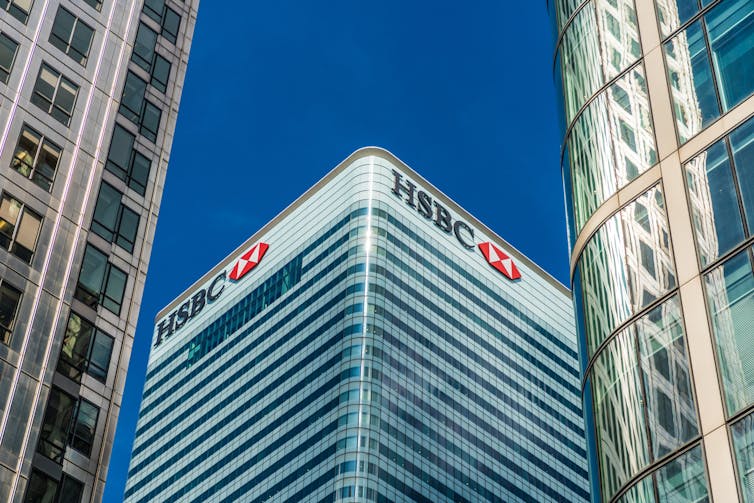
HSBC is moving its UK headquarters from Canary Wharf back into the City of London as it adjusts to the impact of hybrid work on its office space needs.
This could signal the reverse of the 1990s trend of banks moving out of the City in search of buildings more suited to modern banking. The City’s “Square Mile” financial district is considered the historical centre of British banking. But space and planning restrictions on building expansions made a move to Canary Wharf very appealing as banks navigated the new world of electronic trading, starting in the 1980s.
HSBC’s predecessor, Midland Bank, opened grand offices at 27 Poultry, next to the Bank of England, in 1924. But after its takeover by HSBC in 1992, this office was vacated for more modern premises on Lower Thames Street.
A subsequent move by HSBC to Canary Wharf in 2002 came more than a decade after the first tenants moved to this new site – Morgan Stanley, Credit Suisse, First Boston and Citigroup. Barclays was the last major UK retail bank to leave the City’s Lombard Street for Canary Wharf in 2005.
HSBC is now heading back to the City 21 years later, possibly at the forefront of another wave of migration, as UK-based banks adjust to the world of hybrid working practices. If bank staff are working from home for two or three days in a week, space is less crucial. Indeed, office vacancies in London are rising, particularly in Canary Wharf. The City of London, although never down and out, appears to be in ascendance again.
Our previous research into the flight of banks to Canary Wharf showed it was driven by conservation movements that aimed to preserve the City’s historical buildings. In particular, National Provincial Bank (later NatWest) wanted to transform its headquarters in the 1960s from a prestigious Victorian building into a skyscraper fit for modern banking.
Fighting to modernise
Gibson Hall, National Provincial Bank’s original home in the City of London, was built in 1865 and served as the bank’s headquarters for over a century. Victorian banks preferred large, grand, highly-decorated buildings in prime locations for their head offices. They wanted to project wealth, reliability, stability and success. In 1894, the German travel writer Karl Baedeker, wrote in his guidebook to London that Gibson Hall was a “beautiful, in Byzantine-Roman style, richly decorated hall with polished granite columns and polychromatic decoration”.

However, by the 1960s, the Victorian style of Gibson Hall appeared old-fashioned, while the building itself had become ill-suited to modern banking methods. Telephones and computers required wiring and cables that the building had not been built to accommodate. Also, when Gibson Hall was first constructed, just 100 employees worked in the London office. By 1964, this figure had grown to 1,866, excluding non-clerical staff, according to information we found in the NatWest Group archives.
So, National Provincial’s leaders thought replacing Gibson Hall with a new skyscraper would better reflect the needs, size and status of a large and growing modern bank. It could also escape the constraints of an historic building that was no longer fit for purpose.
Unfortunately for National Provincial, a tide of preservation sentiment was building throughout Britain by the 1960s. In 1964, when a public enquiry was held into the demolition of Gibson Hall, our archival research shows attitudes were firmly in favour of preservation of historic buildings.
The preservation movement was fuelled by the demolitions of several London landmarks in the early 1960s, including the Coal Exchange in Lower Thames Street and the “Euston Arch” entrance to Euston station, both Grade II listed. This provoked public outcry. A preservation order placed on Gibson Hall in 1964 blocked National Provincial from demolishing its Victorian home to replace it with a modern tower block.
Out with the old
Many banks had offices and branches in Victorian or Edwardian buildings at this time. The preservation order placed on Gibson Hall gave a clear signal that such buildings should stand. By the 1980s there was still a powerful conservation lobby.
But City firms’ need to expand and update their office space took on a new urgency following financial deregulation, known as the “Big Bang”, in 1986. As well as replacing face-to-face share dealing with electronic trading, the reforms allowed more banks to start trading, not just advise investors.
In addition to computers, banks now wanted large floor spaces for their traders. They needed more equipment and connections for computers and air conditioning to stop the tech overheating. It was more cost-efficient to house this activity in an open-plan environment where cables could be run through the space more easily. Ventilation systems would also operate better in open areas versus small, individual offices.
The Canary Wharf development on London’s Isle of Dogs seemed to offer everything the banks needed at this time. It had been designated as an Enterprise Zone, which removed virtually all planning constraints. This allowed for the construction of a new financial hub unencumbered by the delays inherent in planning enquiries.

Of course there were teething problems during the construction Canary Wharf – not least the impact of the 1989-92 property crash on financing for the build. But it eventually gave UK banks what they had wanted for so long: a free hand to build huge skyscrapers. These superstructures not only housed much-needed modern technology, they also served as a monument to their inhabitants’ economic power and prestige.
The movement of HSBC’s headquarters signals another potential shift for banks, but this time to smaller offices to accommodate changing working practices once again. While HSBC was not the first bank to move to Canary Wharf 30 years ago, other banks could follow its lead this time to head bank to the City as hybrid working affects these companies and their employees.
The authors do not work for, consult, own shares in or receive funding from any company or organisation that would benefit from this article, and have disclosed no relevant affiliations beyond their academic appointment.
This article was originally published on The Conversation. Read the original article.







